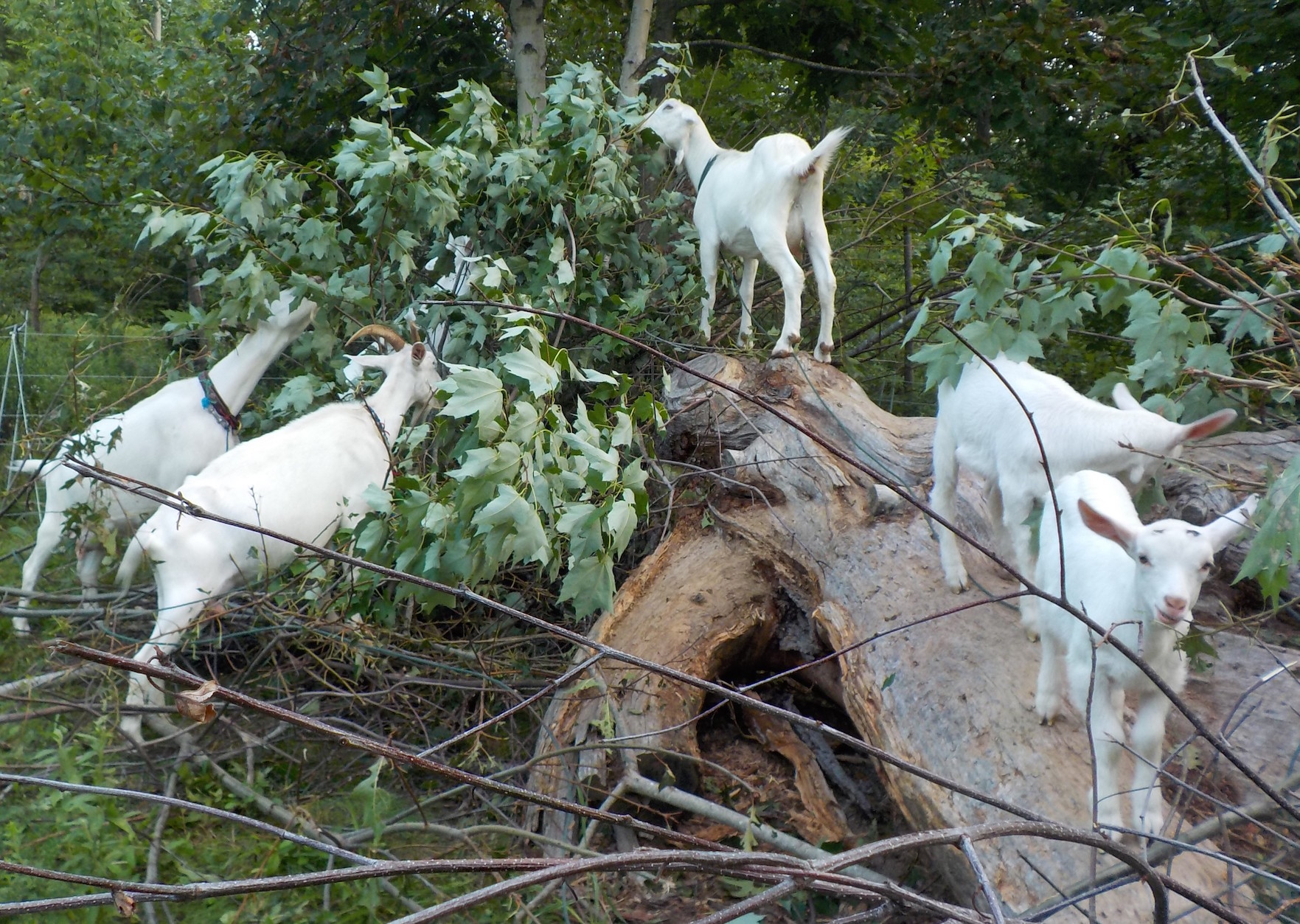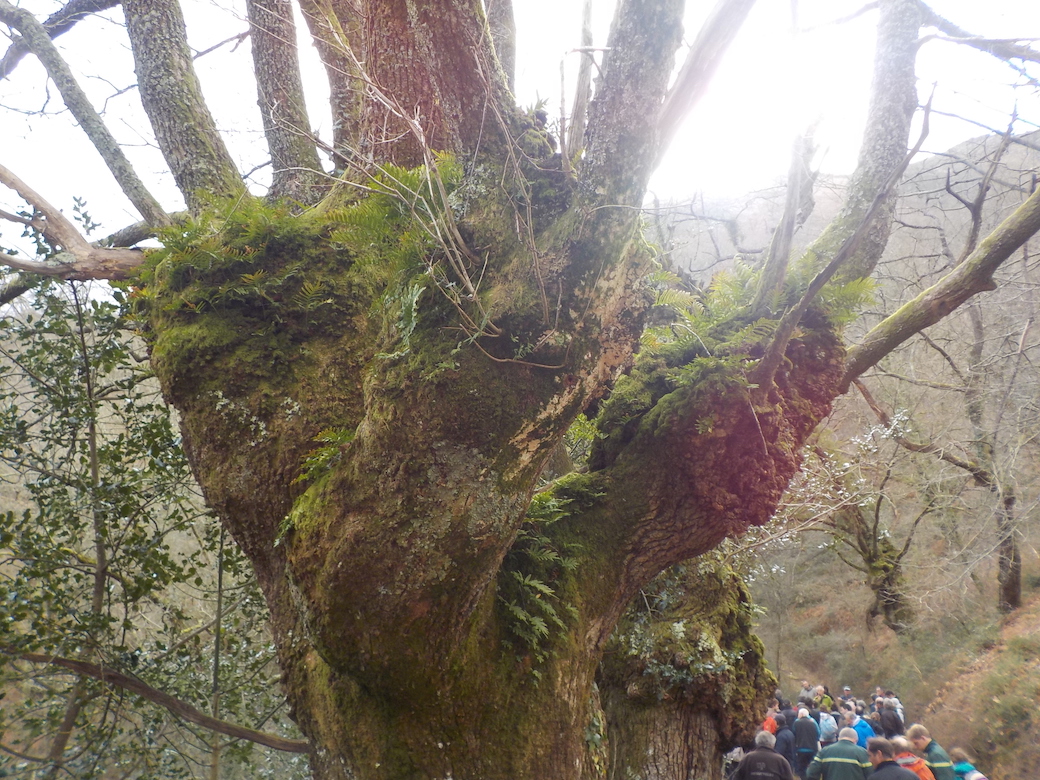Silvopastoral models often address canopy closure over time by harvesting whole trees, yet regeneration requires expensive protection of saplings, or long periods of livestock exclusion. Alternatively, branch harvest opens the canopy (Figure 1) with diminished need for tree replacement, while providing marketable wood products and nutritious fodder (Garmo 1999) more frequently.

Other benefits of canopy harvest are well-researched but less obvious. Fertility contributions of trees are enhanced when trees are heavily and cyclically pruned (pollarded). Nitrogen is released to ground vegetation from tree root die-back post pruning (Austad and Losvik 1998); such root turnover also increases ground resilience to both water-logging and drought (Ninemets and Valledares 2006). Leaves from pollarded trees are more nutritious than from felled trees, for both livestock (Figure 2) and soil. Leaf drop in years between harvests combined with above-mentioned nitrogen release made manure applications unnecessary in traditional wooded hay meadows (Austad et al. 2003a).

Biodiversity: When branch structures are shortened, sunlight can reach a diversity of levels. Foliage Height Diversity (FHD) is such a close correlate to biodiversity that researchers measure FHD as a biodiversity indicator. Life spans of trees in Europe were doubled by traditional 3 to 8 year harvest cycles (Read 2006; Watkins 2014). Ancient European fodder trees still living today house rare and endangered life forms in their sunshine-warmed, broad, and complex trunks (Figure 3).

Resilience: Leaf fodders offer health benefits to livestock and livestock product consumers (Hardy 2009; Prache et al. 2005). Trunk, root, and branch storage of carbohydrates and water surpasses storage capability of sod when weather is irregular (Austad 2003b; Kays and Canham 1991). Pollarding protects trees from storm breakage, and increases pest and disease resistance. Under a SARE-funded project (Hanson 2018), we processed leafy branches in various ways for cattle, sheep, goats, and hogs. Positive responses of the livestock to most of these fodders, and drought-related grass shortages, are incentives to address the sticking point of labor time.
Re-structuring: Height is unavoidable, as sprouts must be out of reach of livestock. Most mature trees do not tolerate a large trunk cut, but a taller branched form is highly productive; alternatively, a “shred” with all branches and top removed provides fodder while becoming a saw log. Farmers needing efficiency can choose one ladder and/or rechargeable power pole saw, and aim trees toward one or two heights. An arborist can help initially; subsequent harvests are more manageable. If able to delay entry of livestock, one can “single” coppice sprouts from felled trees to one from each “stool” (Tabor 1994), or plant or select saplings. Tops of young trees can be cut at 3-inch diameter (traditionally the size of “a woman’s lower arm”, or “wine bottle”) to begin one central boll.
Wood products: Hardwood branches sell for $200/cord here to a producer of grilling chips. Sy Schotz from Belfast, ME is selling goat-stripped maple branch snaths. Lizzy Hayes and Geoff Nosach from Mercer, ME grow shitake commercially in cut branch wood. The even size of fodder refuse suits bio-char production ( https://www.youtube.com/watch?v=l0duKb3CAgE&t=1s ). Internationally, companies are mechanically harvesting and bio-massing pollard branches (Monier 2018; Guerrere 2018).
Dried leaves: Stack whole branches under a tarp or in the barn. Nick Jackson from Belmont, ME ties branch armloads to a center pole (dead fir), butts down, and adds with an occasional pass of rope (http://www.jacksonregenerationalfarm.com/resources.html). Goats are more likely to climb the pile if horizontal (http://3streamsfarmbelfastme.blogspot.com/p/sare-grant.html; click on “PHOTO FOLDERS” next to “Data” near top, then “Storage,” then “Dried leaf piles”). Traditional sheaves offer tarp-free ways to stack, but take time and skill. We sheaved and racked traditionally during Tree Fodder Seminar 2016. Ensiled leaves (Figure 4) are more digestible than dried (Austad et al. 2003b; Machatschek 2002).

Ash, aspens, and willows snap easily by hand; twigs can be included. Limited air space is acceptable, so long as containment prevents air flow. A chipper/shredder is faster; adjust the speed to make large pieces, so that animals can sort leaves from woodchips. We used buckets or lever-sealed plastic barrels, with a filled plastic bag at the top to help seal. During Tree Fodder Seminar, July 8-12, 2019, we plan to chip branches to fill a one-ton tote and try bale wrapping (http://3streamsfarmbelfastme.blogspot.com/p/2018-tree-fodder-seminar.html).
References
Austad I, Braanaas A, Haltvik M (2003a) Lauv som ressurs: Ny bruk av gammel kunnskap. HSF 4/03 (English summary pp 121-122). Høgskulen i Sogn og Fjordane, Sogndal
Austad I, Hamre LN, Rydgren K, Norderhaug A (2003b) Production in wooded hay meadows. In: Tiezza E, Brebbia CA, Uso JL (eds) Ecosystems and Sustainable Development - IV Vol. 2. WIT Press, Southampton UK
Austad I, Losvik MH (1998) Changes in species composition following field and tree layer restoration and management in a wooded hay meadow. Nordic J. of Botany 18(6): 641-662
Garmo T (1999) Mineral content of tree and shrub leaves from indigenous pastures. In: Papanastasis VP, Frame J, Nastis AS (eds) Grasslands and woody plants in Europe; Proceedings of the International Occasional Symposium of the European Grassland Federation, Thesalonski, Greece, May 27-29, 1999: 65-7.
Guerrere V (2018) The use of locally-sourced biomass in the energy sector – an opportunity for the (re)development of the bocage (example from the tropics). In Balaguer F (coord) et al, Proceedings of the 2nd European symposium on pollarding, 1-3 March 2018, Sare France. Will soon be posted at www.agroforesterie.fr/trognes
Hardy K (2009) Notes on a Lost Flute: A Field Guide to the Wabanaki. Down East Books, Camden ME
Hanson S (2018) Tree Leaf Fodder for Livestock: Transitioning Farm Woodlots to ‘Air Meadow’ for Climate Resilience. SARE. https://projects.sare.org/project-reports/fne18-897/ Accessed 2 April 2019
Kays JS, Canham CD (1991) Effects of Time and Frequency of Cutting on Hardwood Root Reserves and Sprout Growth. For. Sci. 37(2): 524-539
Machatschek M (2002) Laubgeschichten: Gebrauchswissen einer alten Baumwirtschaft, Speise – und Futterlaubkulture. Bohlau, Wien
Monier S (2018) Pollarded ash in the Massif Central mountains – increasing farm autonomy. In Balaguer F (coord) et al, Proceedings of the 2nd European symposium on pollarding, 1-3 March 2018, Sare France. Will soon be posted at www.agroforesterie.fr/trognes
Ninemets U, Valledares F (2006) Tollerance to shade, drought, and waterlogging of temperate northern hemisphere trees and shrubs. Ecol. Monographs 76(4): 521-547
Prache S, Cornu A, Berdague JL, Priolo A (2005) Traceability of animal feeding diet in the meat and milk of small ruminants. Small Rumin. Res. 59(2): 157-168
Read HJ (2006) A brief review of pollards and pollarding in Europe. 1er colloque européen sur les trognes, Vendôme, 26, 27 et 28 octobre 2006: 1- 6
Tabor R (1994) Traditional woodland crafts. Batsford, London
Watkins C (2014) Trees, woods, and forests: A social and cultural history. Reaktion Books Ltd., London
